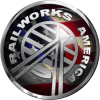
First, let me be clear that all of those cabs were generated from rendered 3D models except for one. The exception was a steam cab that used a composite photo by Steve Thompson as the background. I digitally removed several of the controls and replaced them with 3D objects rendered from a point of view chosen to match the perspective lines of the photo. That's really no different from the way a fully rendered cab is made. Other modelers have used a similar technique, taking cab-interior photos and superimposing controls composed of original artwork, or in some cases artwork from other cabs. You can't do that anymore with 3D cabs and I suspect that might be causing some of the trepidation.
Here are some of the similarities and differences that I see.
** My cabs were, and continue to be, built in 3ds Max. In the case of MSTS, that was because Max can handle not only the modeling but also the interior lighting and rendering. Making cab renderings for MSTS with any other modeling package ranges from difficult to impossible. With RS you can use any supported modeling program. The lighting and rendering are done in real time by RS.
** Since it's ultimately rendered as a 2D image, an MSTS cab can be as polygon-hungry as we care to make it. We have to take a more disciplined approach when building an RS cab, using the same set of tricks we use for exterior models.
** You can apply post-production techniques to an MSTS cab. Details like screw heads, shadows--whatever--can be added to the rendered 2D image using a paint tool. You can't do that with a 3D cab. It's all got to be there to start with.
** 2D cabs are like a movie set. You only have to build the visible parts. With 3D cabs everything is visible, so you have to build the whole thing.
** There's often no "back view" in an MSTS cab. In an RS cab you can look in any direction. If the locomotive has a tender, the one you see from the cab is actually the exterior model. It has its own separate motion relative to the cab, which is cool, but because it's viewed so closely the front of the tender has to be more highly detailed than we would normally bother with.
** Each of the controls in an MSTS cab is a 2D sprite consisting of an array of rendered images representing the various positions of the control. Trust me when I say it's a real pain to make all those renderings and piece them together. In RS the controls are the real thing. You build them, key-frame them, export them, and enter them into your locomotive blueprint. They move the same way when viewed from any angle, and you can grab hold of them and move them from anyplace in the cab.
** There is general a dearth of source data for cabs. That's a problem whether you're building in 2D or 3D. Essentially, you'll have to get permission to take your own photos, or know someone who can do that for you.
Make no mistake, building a locomotive cab for RS--or MSTS--is not a simple undertaking. But building a convincing model of an industrial complex isn't easy either. However, cab-building is no longer something only the "elite" modelers can do. If you can build a piece of rolling stock, you can build a cab. Try it! If you run into any problems, just holler.


 .....still drool facter is maxing out!
.....still drool facter is maxing out! 
